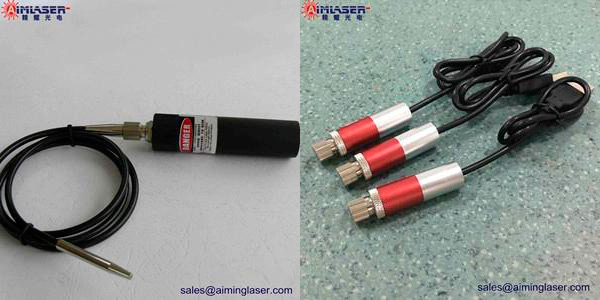Lasers can be divided into fiber lasers, semiconductor lasers, solid-state lasers and CO2 lasers according to material classification. In the industrial application of lasers, fiber lasers are unique. At present, there are more and more types of fiber lasers. According to the different time-domain characteristics of laseroutput, fiber lasers can be divided into pulsed fiber lasers and continuous fiber lasers. Different types of fiber lasers have different typical applications in the industrial field.
A pulsed laser refers to a laser whose pulse width of a single laser is less than 0.25 s and only works once at a certain interval. The main feature of pulsed fiber lasers is that the peak power is high, but the average power is generally low. It is mainly used in laser marking, engraving, ranging and other fields. First, the anodized aluminum is non-tactile and marked black. Marking black is a typical representative of the differentiated competition of light sources. Logos, characters, and small characters can be marked with black on anodized aluminum, which has a wide range of applications in mobile phone processing. Second, laser ink/PVD removal. As the structure of mobile phones becomes more and more refined, many parts have residues in some parts after ink and PVD treatment, which will affect the appearance and cannot meet the corresponding requirements of the production process of parts. This requires the use of lasers to remove excess ink or PVD film layers, such as flash ink removal, touch screen ink removal, and camera ink removal. Third, laser cleaning. Laser cleaning is a popular application at this stage. Laser is a kind of light source. As a technical means, it is applied to the cleaning industry in various fields. The more common ones are rust removal, oil removal, paint removal, slag removal, and film removal.

Another typical application that reflects differentiated competition is MOPA fiber lasers. Its waveform and parameter settings have many options, and it has its application advantages in the refined and special marking market. First, laser micro-welding technology. The micro-welding technology of MOPA structure has the following advantages: it is suitable for the welding of various metal sheets with a thickness of less than 0.5 mm; the micro-welding technology mainly adopts a spiral welding method to form micro-soldering joints, which can be well integrated with the underlying substrate. ; Suitable for welding of dissimilar materials, with less thermal influence and less material deformation caused by welding, these are its great advantages. Second, laser deburring. The MOPA structure fiber laser has more options for parameter setting, which has advantages in the application of mobile phone deburring. After the general parts are deburred, the overall aesthetics is greatly improved. Third, laser micro-hole processing. The pulsed fiber laser with MOPA structure is used in the processing of very thin special metal micro-holes. This is its application advantage. The processing material is not deformed, the aperture and the edge of the hole are well processed, and the processing time period can generally meet the needs of normal customers.
The emergence of QCW fiber lasers has greatly changed the application market of lasers and almost replaced the market of lamp-pumped lasers. QCW fiber lasers have typical applications in the following areas.
First, laser spot welding. QCW fiber lasers are suitable for metal spot welding of 0.7 mm or even 1 mm. It has a wide range of applications, such as the packaging of connectors, wires, optical modules, etc., and even automated welding equipment to form batch applications. Second, laser special steel cutting. Another advantageous application of QCW fiber lasers is in the fields of precision thin plate cutting and special material cutting. Third, laser sapphire cutting. QCW fiber lasers have advantages in some less demanding sapphire cutting areas.
The industrial application of continuous fiber lasers is mainly reflected in high-power, high-speed processing.
First, laser cutting. Typical applications such as cost-saving air cutting, technology-embodied small hole cutting technology, etc. Third, laser three-dimensional five-axis cutting. At present, this market has been widely used in the automotive thermoforming industry. Among them, the infinitely rotatable three-dimensional cutting head is its key component, which has the advantages of infinite rotation, magnetic anti-collision, built-in water cooling system, automatic focusing, and high-speed floating shaft. In addition, continuous fiber lasers are also widely used in body-in-white laser welding lines, laser hand-held welding, laser metal 3D printing, and laser ultra-high-speed cladding, which is known as the most competitive process that can replace electroplating technology application.